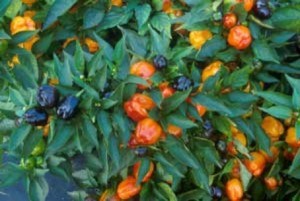
Botanical Name:
Capsicum annuum
Description:
Peppers are members of the Capsicum genus, and have been cultivated to exhibit a wide range of tastes, colors and sizes. Most have a strong, hot or sweet flavor and are used often as condiments or to add flavor and spice to dishes.
Planting Time:
spring or summer
Exposure:
full sun
Soil:
well-drained, nutrient-rich soil with a pH of 5.5 to 6.9.
Planting:
Start seeds indoors 6 to 8 weeks before the last frost or 8 to 12 weeks before transplanting. Because people usually don't need many, it's easiest to start with purchased plants. Set transplants out 2 to 3 weeks before the last frost date or when soil temperatures reach 65ºF. Space peppers 1 _ to 2 feet apart depending on the variety, and allow 2 to 3 feet between rows. Sow seed directly at a depth and rate according to seed packet directions. Plant peppers near tall crops like corn to provide shade and prevent sun scald in warm climates.
Watering:
Keep soil evenly moist (not wet).
Maintenance:
Side-dress plants with a small amount of compost when they start to flower. Cover plants if temperatures are forecasted to dip below freezing.
Harvesting & Storage:
Harvest peppers (even if still green in color) by cutting them from the stems whenever they are large enough to use. Wear gloves when handling hot peppers. Wash skin immediately if you come into bare contact to avoid burns. Peppers will keep in the fridge for up to two weeks or longer when dried.
Diseases and Pests:
Hot peppers generally act as an insect deterrent for the other vegetables in the garden, but can be prone to some of the same problems as tomatoes.
Tips to Success:
Warm weather and consistent moisture are the keys to successfully growing peppers. Northern gardeners should choose early, cold-tolerant cultivars.
